Pump Handbook by Igor J. Karassik, Joseph P. Messina, Paul Cooper, Charles C. Heald - 3rd edition
Подождите немного. Документ загружается.

SECTION 2.2.7.2
CANNED MOTOR PUMPS
STEPHEN A. JASKIEWICZ
2.315
A canned motor pump (CMP) is a combination of a centrifugal pump and a squirrel cage
induction motor built together into a single hermetically sealed unit (see Figure 1). The
pump impeller (A) is normally of the closed type and is mounted on one end of the rotor
shaft that extends from the motor section into the pump casing.The rotor (B) is submerged
in the fluid being pumped and is therefore “canned” to isolate the motor parts from contact
with the fluid. The stator (C) is also “canned” to isolate it from the fluid being pumped.
Bearings (D) are submerged in system fluid and are, therefore, continually lubricated.
The canned motor pump has only one moving part, a combined rotor-impeller assem-
bly that is driven by the magnetic field of an induction motor. A portion of the pumped
fluid is allowed to recirculate through the rotor cavity to cool the motor and lubricate the
bearings. A self-cleaning filter can be provided, on pumps having external circulation, to
filter the recirculation fluid before it enters the bearing section of the motor. The stator
windings and rotor armature are protected from contact with the recirculating fluid by a
corrosion resistant, non-magnetic, alloy liner (E) that completely seals or “cans” the stator
winding.
Modifications to the recirculation flow system are available to allow canned motor
pumps to be used in any application including fluids up to 1000°F (538°C), volatile liquids,
and liquids with solids.
BASIC DESIGN ______________________________________________________
Stator Assembly
The stator assembly of canned motor pumps (see Figure 2) consists
of a set of one or three-phase windings (A). Stator laminations (B) are constructed of low-
silicon grade steel. Laminations and windings are mounted inside the cylindrical stator
band (C). End bells (D and E), welded to the stator band, close off the ends of the stator

2.316 CHAPTER TWO
FIGURE 1 Typical canned motor pump
assembly. The stator liner (F) is supported on the outside diameter by the steel lamina-
tion of the motor. Back-up sleeves (G) are provided to strengthen those areas of the sta-
tor liner not supported by the stator laminations.The stator liner is, in effect, a cylindrical
“can” placed in the stator bore and welded to the rear end bell and front end bell shroud
to hermetically seal off the windings from contact with the liquid being pumped. Termi-
nal leads (H) from the windings are brought out through a pressure tight lead connector
(I) mounted on the stator band and terminated in a standard connection box.
Motors are either designed and manufactured specifically for use in canned motor pumps
or components of conventional motor are modified. A variety of motor insulation types is
available ranging from temperature limits of 266°F (130°C) to above 482°F (250°C).
Because the pump and motor are one unit, the complete assembly must be tested and
approved for explosion-proof applications. Explosion-proof pumps are rated as either Class
1, Group D, Division 1 or Class 1, Group C & D, Division 1 locations. It is not uncommon
to operate canned motor pumps with variable speed drive controllers.
Rotor Assembly The rotor assembly is a squirrel cage induction rotor constructed and
machined for use in canned motor pumps (see Figure 3). It consists of a machined corro-
sion resistant shaft (A), laminated core (B) with copper or aluminum bars and end rings,
corrosion resistant end covers (C), and a corrosion resistant can (D). Various methods are
used to attach the impeller to the motor shaft (E).
The rotor end covers are welded to the shaft and to the rotor can that surrounds the
outside of the rotor, thus hermetically sealing off the rotor core from contact with the liq-
uid being pumped.
Some manufactures offer replaceable shaft sleeves (F) and axial thrust surfaces (G) for
longer service life and ease of maintenance.
Bearings Only two bearings are required for canned motor pumps. These bearings are
normally cooled and lubricated by the pumped fluid; therefore, they must be compatible

2.2.7.2 CANNED MOTOR PUMPS 2.317
FIGURE 2 Stator assembly
FIGURE 3 Rotor assembly
with the process fluid. A multitude of materials is available such as various grades of car-
bon graphite, silicon carbide, aluminum oxide, and many polymers. Bearing selection is
dependent on the compatibility with the process fluid, amount of solids present, and
pumping temperature.
A hydrodynamic bearing is the most common type of bearing used. The bearings can be
either stationary or rotating with the rotor assembly. In either case, the fluid passes
between the bearing and shaft journal, resulting on the rotating assembly running on a
thin film of liquid, not the journal and bearing. Most bearings have helical grooves in the
inside diameter to increase the flow of process fluid through the journal area, thereby
decreasing the temperature of the bearings.
Internal Clearances The determination of the overall gap between the stator windings
and the rotor armature is paramount in the design and operation of the pump. The wider
the distance between the iron of the motor winding and the rotor armature, the less effi-
cient the motor becomes. The material of construction of the stator liner and rotor sleeve
2.318 CHAPTER TWO
also effects motor efficiency. Stainless steels and Hastelloy are the most common materi-
als used for stator liners and rotor sleeves. Although stainless steel is less expensive,
Hastelloy C has higher corrosion resistance, is a stronger material, and offers lower elec-
trical losses. Motor efficiency in canned motor pumps is not only important for energy cost
considerations, but also for the amount of heat input to the recirculation fluid.
The stator liner (a wetted, pressure boundary component) ranges in thickness between
0.010 to 0.040 in (0.254 to 1.016 mm). For high-pressure applications, the liner remains at
the same thickness, but the outside diameter is supported by the motor laminations and
by back up sleeves located on both sides of the motor. Canned motor pumps have been
designed to withstand working pressures up to 5,000 lb/in
2
(345 bar) with 0.015 in (0.381
mm) stator liners and heavy walled back-up sleeves.
The rotor armature (a wetted component) is also protected from the process fluid by a
sleeve and two end covers. The thickness of the rotor sleeve ranges from 0.010 to 0.25 in
(0.254 to 6.35 mm). The radial running clearance between the rotating motor armature
and the stationary stator liner is usually about 0.020 in (0.508 mm). The total diametral
clearance can range from 0.040 to 0.075 in (1.016 to 1.905 mm), or higher, depending on
the manufacturer’s design.
Secondary Containment Canned motor pumps offer a level of safety and process fluid
containment unavailable with any other type of pump. Positive, secondary containment
of the process fluid is a built-in feature with canned motor pumps when the motor lead
wires are housed in a pressure retaining lead seal. In case of a failure of the primary con-
tainment shell (stator liner), the outer stator band becomes a secondary containment ves-
sel, preventing the process fluid from entering the environment.
The outer stator band is far removed from the rotation element, making it impossible
for the rotating element to make contact. When secondary containment is required, the
stator band assembly should be designed and tested to the same pressure and tempera-
ture rating as the pump.
PRINCIPLE OF OPERATION____________________________________________
Flow Path
Most canned pumps, when pumping relatively clean fluids, will channel a small
portion of the process fluid through the motor section. This fluid cools and lubricates the
bearings and removes heat generated by the induction motor. The circulation path can be
either external or internal to the pump. With external circulation (see Figure 4), the recir-
culation fluid is piped outside of the pump, through a filter, and then into the motor section
of the unit. The filter assembly (see Figure 5) is self-cleaning and located in the discharge
flange of the pump. Pumps having internal circulation have the recirculation contained
within the pump. Filtering the recirculation liquid is not available with internal circulation.
In either external or internal circulation, the flow path is from the high pressure area
of the pump (pump discharge or pump chamber at the tip of the impeller) returning to the
low pressure area (near the hub or eye of the impeller). The amount of liquid recirculated
through the motor section ranges from 2 to 16 gpm (7.5 to 60 l/m).
Many recirculation flow path modifications are available to allow a canned motor
pump to pump any type of fluid. When pumping volatile fluids, the motor section can be
pressurized by an auxiliary impeller located on the rotor. The recirculation fluid, which
normally returns to the eye of the impeller, is channeled to the pressurized section of
the liquid end, increasing the pressure in the motor section. This design allows a
volatile fluid to remain liquid even with a temperature increase caused by motor heat
(see Figure 6). Another method to handle fluids near their boiling point is to reverse the
recirculation flow path. Instead of returning the heated liquid back to the eye of the
impeller, the recirculation liquid is removed from the pump and returned to the suction
vessel.
High temperature and slurry applications can be handled by canned motor pumps by
isolating the bearings from the pumped fluid. The recirculating fluid in the motor section
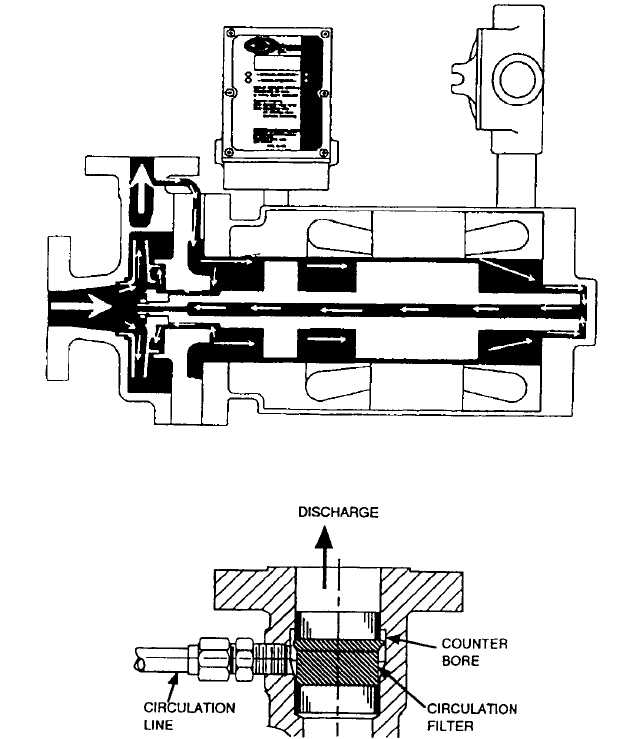
2.2.7.2 CANNED MOTOR PUMPS 2.319
FIGURE 4 External circulation flow path
FIGURE 5 Self-cleaning filter assembly
is used for lubrication of the bearings and cooling of the motor. This fluid remains in the
motor section and is circulated through the rotor cavity by an auxiliary impeller, which is
an integral part of the rotor assembly. The fluid in the motor section is forced across the
rotor and through the bearings, after which it flows through a heat exchanger. The heat
exchanger is cooled by water or a suitable heat transfer fluid (see Figure 7). The motor sec-
tion can be backflushed with a clean, cooled liquid when handling slurry.
In Hydraulic Institute Standard ANSI/HI 5-1-5.6, Figure 5.9 provides an excellent
description of various recirculation flow plans for sealless pumps.
Thrust Balance Because most canned motor pumps use hydrodynamic bearings, the
rotating assembly is allowed to float axially. This movement is known as “end play” and
is defined as the movement of the rotor, in the axial direction, between the forward and

2.320 CHAPTER TWO
FIGURE 7 Isolated motor section
FIGURE 6 Pressurized circulation
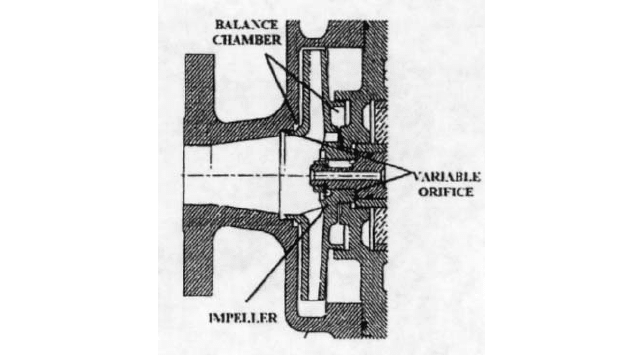
2.2.7.2 CANNED MOTOR PUMPS 2.321
FIGURE 8 Automatic hydraulic thrust balance
rear contact points (normally the thrust bearings). Many canned motor pumps incorpo-
rate a principle of hydraulic thrust balance to position the rotation assembly between the
forward and rear mechanical contact points. Based on hydraulic principles, automatic
thrust balance is accomplished by the pressure of the pumped fluid. Pressure chambers
are designed either within the pump chamber using the movement of the impeller or rear
of the pump controlling the rate of return of the process fluid.
Figure 8 illustrates hydraulic thrust balance within the pump casing. Balance cham-
bers are located on the front and rear of the impeller. When a change in axial load changes
the position of the impeller, either forward or rear, there is an equalizing change of
hydraulic pressure in the balance chambers, which immediately returns the rotation
assembly into a balance position.
Pressure-Temperature Profile The single most important consideration in the
application and successful operation of canned motor pumps is bearing environment
control. The process fluid cools and lubricates the bearings and removes the heat gen-
erated by the motor. The bearings must remain in a liquid state to provide adequate
bearing lubrication.
A number of variables must be considered when considering the state of the recircula-
tion fluid. These variables include vapor pressure, specific heat, specific gravity, viscosity,
pump efficiency, motor efficiency, motor load, recirculation flow rate, and the recirculation
flow system. A vapor pressure curve versus temperature of the process fluid is also neces-
sary. Figure 9 illustrates heat balance equations necessary to determine the temperature
rise of the fluid within the motor section. Figures 10a, b, and c show pressure and tem-
perature profiles for a specific fluid based on the heat balance equations within a canned
motor pump modified for pressurized circulation. If the flow rate varies, a new profile
should be calculated for each design condition.
A pressure-temperature profile should be calculated for any application where there is
doubt concerning the condition of the recirculation fluid.
Installation The installation of a canned motor pump can be much less costly than a
conventionally sealed unit because canned motor pumps do not require special base-
plates or mounting pads. In fact, many canned motor pumps are stilt-mounted or bolted
directly into the system piping. There is only one shaft in a canned motor pump; there-
fore, alignment of the pump to the driver is not necessary and pump orientation is not
critical. The unit can be mounted either horizontally or vertically, with the pump casing
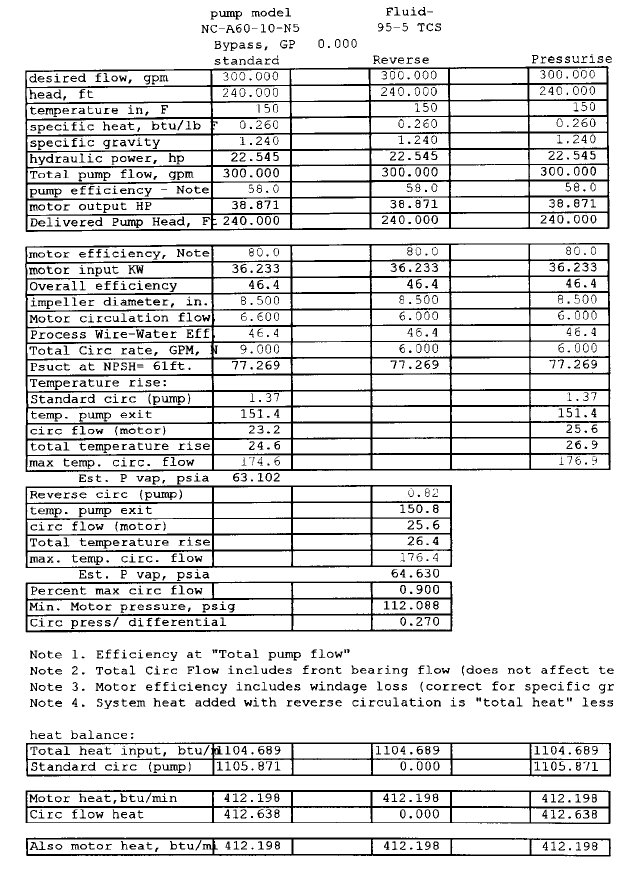
2.322 CHAPTER TWO
FIGURE 9 Heat balance calculations
up or down. The sleeved bearings are located in the bearing housing. Alignment of the
bearings is accomplished by a register fit between the bearing housings and the stator
assembly.
Diagnostics Some canned motor pump manufacturers have developed diagnostic sys-
tems that monitor the condition of the internal wear surfaces of the pump. Because the
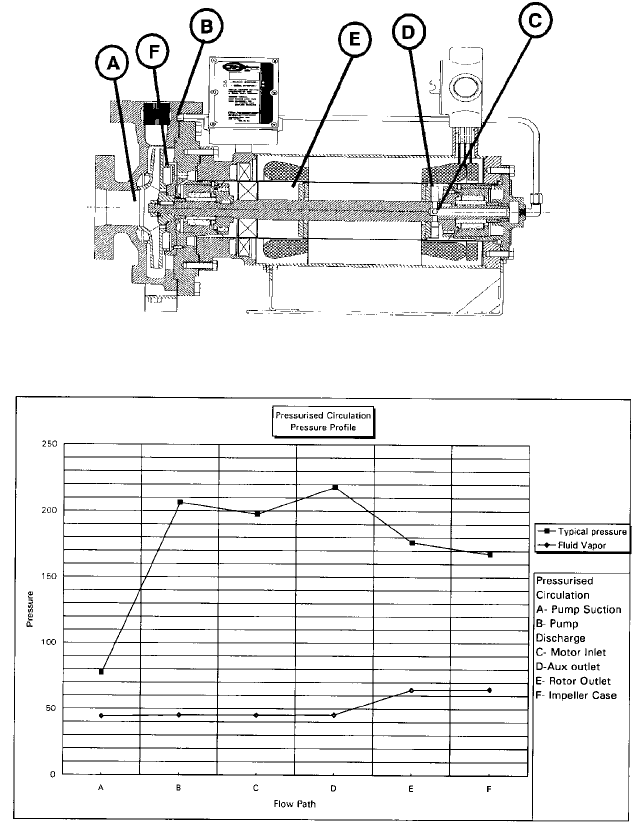
2.2.7.2 CANNED MOTOR PUMPS 2.323
FIGURE 10A Pressurized circulation—points of reference
FIGURE 10B Pressurized circulation pressure profile
rotating components of the pump are not visible, even the direction of rotation can not be
easily determined.
Advanced diagnostic systems indicate both axial and radial wear continuously. Con-
tinuous wear indication allows the pump user to trend the wear of the pump and sched-
ule standard wear parts replacement long before a major failure occurs.
Remote outputs are also available on these diagnostic systems. These outputs include
either a digital or analog signal, or a relay designed to shut down the pump
—
or signal an
alarm
—
when a certain amount of bearing wear has occurred.
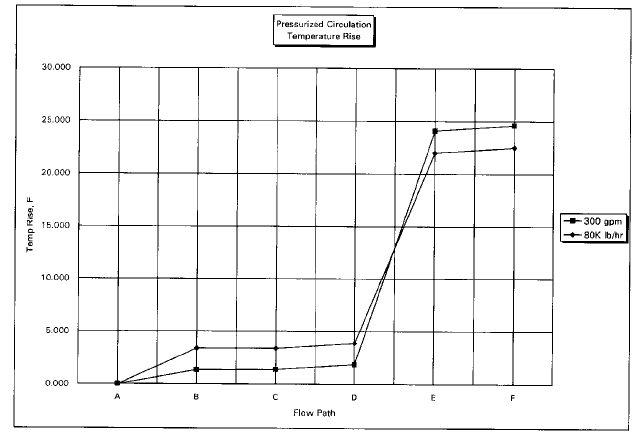
2.324 CHAPTER TWO
FIGURE 10C Pressurized circulation temperature rise
The diagnostic systems available today are perhaps the most significant advance-
ment in the technology of sealless pumps. Figure 11, rotor position output data, illus-
trates the type of information available when using digital output linked to a data
collection system.
